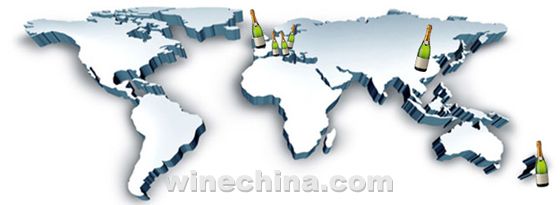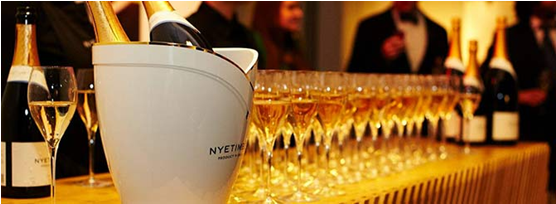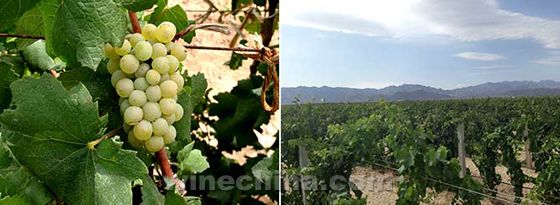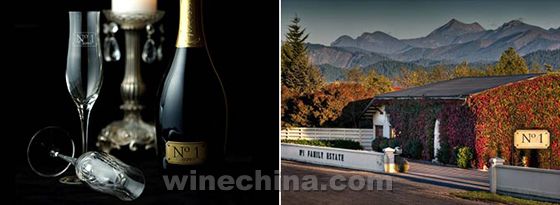Dateㄩ
2014-02-24 12:37 Sourceㄩ
winesearcher Author:
Tom Stevenson Translator:
Tom Stevenson considers the potential of sparkling wine regions beyond Champagne.

England, China, New Zealand, and Slovenia are on Stevenson's sparkling wine radar
It is difficult for anyone accustomed to drinking good-quality Champagne to be satisfied with a sparkling wine from anywhere else. I suppose that is due to conditioning as much as terroir, but, as far as aficionados are concerned, Champagne has that special something that sets it apart from other sparkling wines. Yet the quality of sparkling wines made beyond Champagne*s borders has never been more exciting and that excitement is a very, very recent phenomenon.
The first world-class sparkling wine to be produced outside the confines of Champagne was the second release of Roederer Estate in Anderson Valley, and that did not find its way onto the shelf until the early 1990s.
Today*s buzz of excitement about English sparkling wine was started by the two Americans who founded Nyetimber and made headlines when their 1992 vintage was served at the Queen*s Golden Anniversary Lunch in 1997. Just 15 years ago there were only two world class sparkling wines you could buy. Now there are more serious quality sparkling wines than you can shake a swizzle stick at.
Why the sea change?
Although traditional method sparkling wines become effervescent through the same winemaking process, the key to creating classic sparkling wines literally lies in the soil. Not so much what that soil is, but what vines are planted in it and how they should be cultivated.
Chalk gives Champagne an advantage, but it cannot be responsible for more than, say, 10 percent of a wine*s potential (possibly much less), whereas climate must represent most of the remaining 90 percent.
However, what really drives sparkling wine producers towards greatness on this planet is the selection of clonal material that is best suited to sparkling rather than still wine production, and then pruning and cropping accordingly.
This has certainly been the strategy that has made English sparkling wine the overnight sensation it has become, although it should be stressed that this has been achieved by a small minority of English sparkling wine producers, with the rest basking in their reflected glory.

Nyetimber is widely considered to be one of England's best sparkling wine producers
It should also be pointed out that France has adopted the opposite of this strategy.
In 1998, I noted: "The one country that is lagging behind in the fizz stakes is, ironically, France. With the obvious exception of Champagne, the French still treat sparkling wine as a convenient means of getting rid of unripe or substandard grapes, and this results in some of the nastiest sparkling wines produced anywhere in the world.§
More than 15 years later, the situation remains the same.
The French need to understand that unripe or substandard grapes can only produce unripe or substandard wines. Bubbles cannot magically transform a sow*s ear into a silk purse.
The great pity is that Burgundy could 每 and should 每 be the second greatest sparkling wine region in the world. All it would take is to identify the most promising areas for sparkling wine production and delimit those vineyards exclusively for the production of a superior Cr谷mant de Bourgogne appellation. It is not as if those vineyards would be a great loss to the rest of Burgundy.
I don*t think that New World sparkling wine producers need worry about competition from Burgundy. Even if the region started to get serious about its own sparkling wine potential today, it would take 20 years to develop into an effective competitor.
Top five sparkling wine regions of the future
There are lots of possibilities, including regions that are currently established or emerging.
Over the last year I have been surprised by a number of attractive sparkling wines tasted for the very first time from relatively obscure origins, such as the 2008 Alexandrovic Trijumf Brut (100 percent Chardonnay grown on brown forest soils of Vinca in the Oplenac region of Serbia).
Then there are unlikely sparkling wine grapes, such as the second release of Domaine Karanika Brut 每 this 100 percent Xinomavro is grown in the high-altitude Amyndeo region in Greece, not far from the Albanian border.
Similarly, a Slovenian producer has really stepped up its game: Istenic's No 1 Cuv谷e Speciale, is a non-vintage blend of 70 percent Chardonnay and 30 percent Rumeni Plavec. But one-offs apart, here are my regional picks:
The long view
China 每 Domaine Chandon China is already producing an acceptable quality of sparkling wine that is due to be released on the local market later this year.
Chandon*s vineyards might be on Ningxia*s flat desert plain, but they are 800 miles west of, and infinitely superior to, China*s rot-prone east coast, where so many ventures have been set up in the past.
Even so, many viticultural experts believe that areas with much greater potential for every type and style of wine exist in this vast country. However, most are inaccessible and will remain so until a transport infrastructure has been developed.

Chandon's vines in the Chinese province of Ningxia
Benefitting from climate change
England 每 These vineyards are teetering on the too-cool side of the perfect climate for sparkling wine, but the warmer it gets, the better it is for southern England. If it were any cooler and the growing season any longer, the acidity would become unbearable and ripeness wouldn't occur.
It has everything to gain from a warmer climate 每 it would allow earlier picking without affecting the ripe acidity to sugar balance, and the earlier the harvest, the lower the danger of rot from inclement weather.
Furthermore, most vines have been planted very recently and quality should improve as the vines become more mature. Time will also increase stocks of reserve wines, which have been practically non-existent despite the hype over quality.
There are a number of potentially exciting sparkling wine estates in the pipeline, thus things can only get better for English sparkling wine.
Beating climate change
Champagne 每 All climate change has done so far is to bring this region*s ripening season closer to how things were in 1947, which was one of the greatest vintages of the 20th century, despite its relatively low acidity.
In the long term, the Champenois have to recalibrate the vineyards, replacing current vines with slightly later ripening clones to avoid the small diurnal temperature difference of August harvests, but this is doable and Champagne has far too much to lose not to do it.
In the meantime, there are various tweaks in the vineyards and winemaking processes that can, are and will be developed as part of any temporary fix.
Best unrealized potential
New Zealand 每 Just why more people are not diversifying or even specializing in sparkling wine here is baffling.
They need more sparkling wine producers competing to drive quality up and styles out. The only thing that surprises me more is why every grande marque Champagne house is not setting up shop here. Not only is the terroir brilliantly suited for classic quality brut-style sparkling wine, but the financial plan is a cinch.
This is a country that has so much more going for it than Sauvignon Blanc, yet New Zealand Sauvignon Blanc, particularly Marlborough Sauvignon Blanc, is so consistently good that it acts as an iconic door opener for all the other varieties grown here.

No.1 Family Estate | The wines of No. 1 Family Estate in Marlborough, made by Frenchman Daniel Le Brun, show that New Zealand has the potential to make fine, long-lived sparkling wines.
Some Kiwis are so embarrassed by the success of their methoxypyrazine-loaded Sauvignon Blanc that they are in danger of throwing out the baby with the bathwater. Not only should they not, but its extraordinary marketing success should be used as a blueprint for the development of a great New Zealand sparkling wine industry.
Sparkling Sauvignon Blanc (something else that brings a blush to many a Kiwi*s face) is such an obvious cash-cow from which to fund the more serious classic-quality brut-style sparkling wine. If it is churned out from a big vat with as little yeast contact as possible, it would sell like hotcakes, especially to those airheads who have gone from Chardonnay to Pinot Grigio to Sauvignon Blanc.
The transition from still to sparkling Sauvignon Blanc is such a no-brainer that it would soon outsell Prosecco and at a higher price, too. There are not many sparkling wine ventures anywhere in the world that can expect a cashflow from year one, but with the recent multi-thousand-hectare plantings of Sauvignon Blanc in Marlborough, you could do it a hundred times over in New Zealand.
Outside chance
Northeastern Germany 每 When looking at potential new sparkling wine areas adapting to climate change, the area to the east, north and south of the country's capital, Berlin, stick out like a collective sore thumb. Any south-facing slope would do, according to the latest climatology studies.